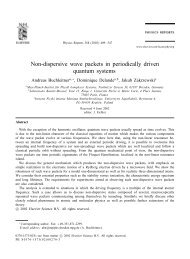Search for Time-Variation of the Electron-Proton Mass Ratio (μ) with ...
Search for Time-Variation of the Electron-Proton Mass Ratio (μ) with ...
Search for Time-Variation of the Electron-Proton Mass Ratio (μ) with ...
- No tags were found...
You also want an ePaper? Increase the reach of your titles
YUMPU automatically turns print PDFs into web optimized ePapers that Google loves.
<strong>Search</strong> <strong>for</strong> <strong>Time</strong>-<strong>Variation</strong> <strong>of</strong> <strong>the</strong><strong>Electron</strong>-<strong>Proton</strong> <strong>Mass</strong> <strong>Ratio</strong> (μ) <strong>with</strong>milliKelvin Trapped Molecular IonsBrian OdomEnrico Fermi InstituteAbstractMost extensions <strong>of</strong> <strong>the</strong> standard model predict that if <strong>the</strong> fundamental constants vary <strong>with</strong> time,<strong>the</strong> electron-proton mass ratio should change 30-40 times more rapidly than <strong>the</strong> fine structureconstant. However, in current model-independent laboratory searches, sensitivity to timedependence<strong>of</strong> <strong>the</strong> electron-proton mass ratio lags behind that <strong>of</strong> <strong>the</strong> fine structure constant bytwo orders <strong>of</strong> magnitude. I present a proposal to improve sensitvity to time-variation <strong>of</strong> <strong>the</strong>electron-proton mass ratio using spectroscopy on milliKelvin trapped molecularions. Specifically, <strong>the</strong> molecular ions <strong>of</strong> interest have a long-lived electronic state nearlydegenerate <strong>with</strong> a highly-excited vibrational level <strong>of</strong> <strong>the</strong> electronic ground state.
Leading (Model-Independent) ResultsFine structureconstantαQuasar absorption lines:For Cs μwaveclockΔ ν
Sympa<strong>the</strong>tic Cooling <strong>of</strong> Molecular Ions to ~ 10 mK(already demonstrated in Schiller and Drewsen groups)HD + cooled to 20 mK by Be + (cloud shapes well understood)Bly<strong>the</strong>, Roth, Frohlich, Wenz and Schiller, PRL 95, 183002 (2005):• Cooling is better <strong>with</strong> smaller clouds,down to 2x atomic ion temperature• Crystal can be turned <strong>of</strong>f, unwantedions ejected, <strong>the</strong>n recrystallizedSee also• Drewsen et al <strong>for</strong> MgH +• Schiller et al <strong>for</strong> mass 410 “Alexa Fluor 350”
Sensitivity <strong>of</strong> Molecular Vibrations to ΔμSensitivity <strong>of</strong> interval:∂Ω / ΓFOM 1 ≡ × 10∂μ/μ−15( number <strong>of</strong> line widths shifted,in response to Δμ / μ = 10 −15 )Monitoring <strong>the</strong> nth vibrational harmonic oscillator state:E ≈nω∝nnvibμ − 1/2FOM 1Maximize FOM 1 by monitoring:• a high-n level• <strong>of</strong> a tightly bound oscillator—large ω vib• <strong>with</strong> narrow linewidth=12nω vibΓ
Limitations <strong>of</strong> FOM 1Some systematics, such as clock instability or dopplershift, impose fractional frequency errorConsider monitoringΩ =Ω= nω∝vibEnA fractional uncertainty( )−15σ ΔΩ / Ω = 1×10 imposes( )−15σ Δ μ/ μ = 2×10regardless <strong>of</strong> whe<strong>the</strong>r FOM 1 isincreased by using a higher nA larger FOM 1 doesn’t always help. Wewould like precision enhancement.n−E01/2μ −
Precision Enhancement, FOM 2Exploit a DegeneracyAngstmann, Dzuba, Flambaum, Nevsky, Karshenboim, J Phys B, 39 (2006)Nguyen, Budker, Lamoreaux, Torgerson, PRA, 022105 (2004)DeMille, Sainis, Sage, Bergeman, Kotochigova, Tiesinga, arXiv:0709.0963Consider monitoringσσΔΩ / Ω = 1×10( )−15Δ μ/ μ = 2×10( )−18Ω =E −E′−3With a degeneracy <strong>of</strong> Ω= 10 En,a fractional uncertaintyMuch better!now imposes• Molecular complexity is definitely a good thing here• A long-lived state is needed• Added benefit: effect <strong>of</strong> clock’s dependence on α, μ suppressedn
Vibrational / F.S. Degeneracy ProposalFlambaum, and Kozlov, PRL 99, 150801, (arXiv posted May 2007)Approach: exploit degeneracy between low-n level and spin flip.Ion trap suggested <strong>for</strong> charged species.shift sens. prec. enh. reachSensitivity: decentPrecision enhancement: goodRange <strong>of</strong> molecules: goodAdvantage: ion trap
Cesium ProposalDeMille, Sainis, Sage, Bergeman, Kotochigova, and Tiesinga, arXiv:0709.0963 Sept. 2007Approach: exploit degeneracy between high-n leveland electronic level, in laser-coolable speciesSensitivity: goodPrecision enhancement: goodto excellentRange <strong>of</strong> molecules: noneAdvantage: cesium technology,both FOMs good
This ProposalApproach: exploit degeneracy between high-n leveland electronic level, in ion trapshift sens. prec. enh.reachSensitivity: good to excellentPrecision enhancement: goodto excellentRange <strong>of</strong> molecules: largeAdvantage: top scores in allcategories
Comparison <strong>with</strong> Cs ProposalIn favor <strong>of</strong> Cs proposal:Atomic Cs technology is well-developedIn favor <strong>of</strong> this proposal:More general technique—choose from entire periodic table• Better figures <strong>of</strong> merit• Study <strong>of</strong> multiple molecules
Systematics & Ultimate ReachInitial work will be on large cloud, but here we estimate reach <strong>of</strong>ultimate single-molecule experiment, based on current ion clocksFor <strong>the</strong> case <strong>of</strong> Se 2+ (0.17 Hz shift <strong>for</strong> Δμ/μ = 10 -15 ) :EffectShift (μHz)Uncertainty (μHz)σ(Δμ/μ) ∗ 10 -191 st -order Doppler00.000 1~02 nd -order Doppler0.0020.002~0Quadratic Zeeman, DC1000504Quadratic Zeeman, AC100503Electric Quadrupole01006Stark, micromotion50503Stark, blackbody~0~0~0Stark, light shift???• Note that 100 μHz accuracy is already achieved in NIST 7-Hg-ion μwave clock•1 st and 2 nd -order Doppler shifts are very small due to μwave spectroscopy in trap• μwave spectroscopy also allows large trap and low AC fields, reducing systematics• Cryogenic operation is required to obtain a low blackbody stark shift
Comparison <strong>of</strong> ProposalsIon trap, high Eby direct driveLattice, mediumE by direct drivefreq. shift sens. prec. enh. reachIon trap, low E<strong>with</strong> degeneracyFountain, mediumE <strong>with</strong> degeneracyIon trap, high n<strong>with</strong> degeneracy(Spontaneous emission lifetimes not yet calculated, but can be > 1 s)This proposal allows sensitivity to Δμto potentially pass current limits on Δα
Conclusions• Linear rf-trap, allows <strong>for</strong> great μwave clocks• Entire periodic table is <strong>the</strong> playground <strong>for</strong> Δμ• Deep potential wells• Accidental degeneracies• Orders <strong>of</strong> magnitude sensitivity improvement to Δμ• In search <strong>of</strong> <strong>the</strong> right physical-chemist• New area <strong>of</strong> research—expect o<strong>the</strong>r applications• Parity violation studies• Low-temperature chemistry• …











